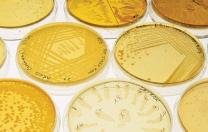Archaea: One of three major domains, or classifications, of life, archaea are morphologically similar to bacteria, but have a different molecular transcription machinery, indicating an ancient evolutionary divergence.
Bacteria: One of three major domains of life. Bacteria are single-celled microorganisms with neither a nucleus nor organelles (specialized intracellular structures; see below).
Cyanobacteria: A division of bacteria that produce their energy through photosynthesis. Formerly called blue-green algae (hence the name “cyano,” or blue, bacteria), they are not “true” algae. Algae are eukaryotes, while the cyanobacteria are prokaryotes.
Eukarya: One of three major domains of life, the eukarya include all single and multicellular organisms in which the cells have a distinct nucleus. Examples are plants, animals, and fungi. The classification includes everything that is not a bacterium or an archaean.
Microbe: Generally considered to include all life that cannot be seen with the unaided eye, microbes are found in all three major divisions of life and include all the bacteria, all the archaea, and some of the eukarya. Some scientists say that only prokaryotes (see below) should be considered microbes, thereby excluding even single-celled fungi. Others argue that even multicellular organisms can be considered microbes. Mushrooms, for example, are the multicellular fruiting bodies of fungi that may start as unicellular organisms in the soil. Furthermore, both unicellular bacteria and archaea form aggregates (“colonies”) on surfaces, often referred to as biofilms, that exhibit distinctive multicellular patterning.
Organelles: Structures within a cell that perform specialized functions, such as energy production. Mitochondria and chloroplasts are examples of energy-producing organelles that are thought to have evolved from autonomous bacteria. Eventually they became dependent on their hosts—and vice versa.
Primary production: Production is the creation of new organic matter. Primary production refers to the creation of new organic matter by photosynthetic microbes.
Prokaryotes: An inclusive term that refers to the bacteria and archaea, single-celled organisms that, as distinct from eukaryotes, lack a nucleus.








